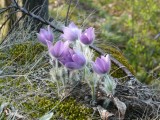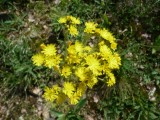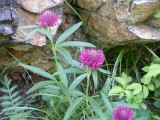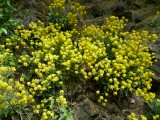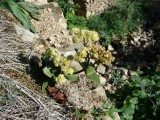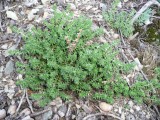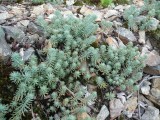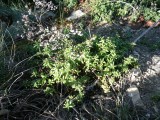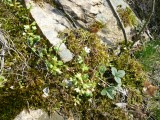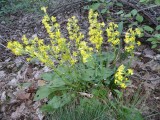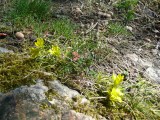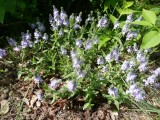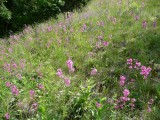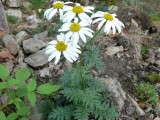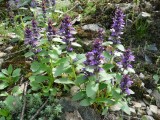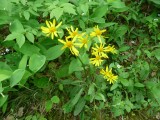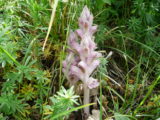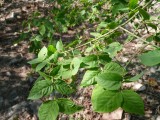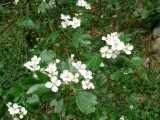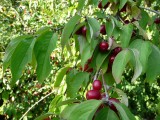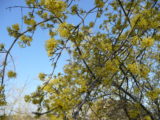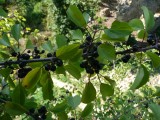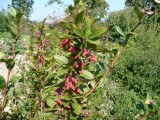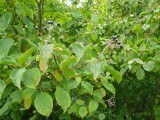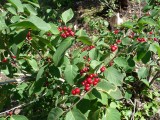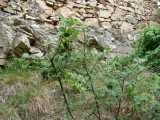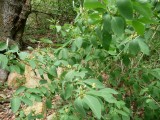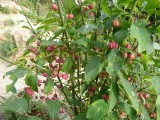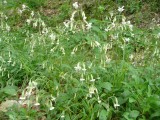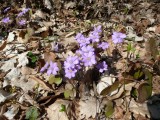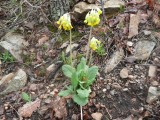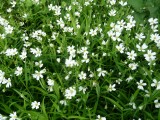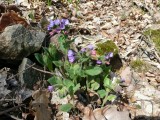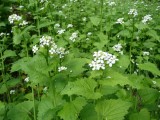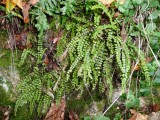Plants
Varied geological conditions contribute to the rich structure of species of plants. A part of hillsides has a character of rock walls and outcrops with poor and intermittent soils. Floating rubble fields forms a part of the area. There are richer soils at gradual hillsides verging into wet places in glens. Subsoil and the quantity of moisture have the influence to the structure of species. Deciduous woods of old limes and oaks cover gradual and shady hillsides. Stunted oaks and pines verging to lower shrubs cover dry and steep places. Tops of rocks, walls and parts without woods have a character of dry steppes with thermophilic plants. Due to the quantity of different types of the undergrowth there are many rare species directly on the area of the castle and in its close surroundings.
Many protected plants are a part of rich steppe communities or rock vegetations. Yellow flowers of rare Early Star-of-Bethlehem (Gagea bohemica) are in bloom in the early spring. Another protected flowers as Greater Pasque Flower (Pulsatilla grandis), Goldentuft Alyssum (Aurinia saxatilis), Rue-leaved Saxifrage (Saxifraga tridactylites), White Mountain Saxifrage (Saxifraga paniculata) and others are in blossom in spring. Local undergrowths are rich in the Small Yellow Onion (Allium flavum), Mountain Garlic (Allium senescens subsp. montanum) and several Stonecrop species – Goldmoss Stonecrop (Sedum acre), White Stonecrop (Sedum album), Showy Stonecrop (Hylotelephium maximum), Tasteless Stonecrop (Sedum sexangulare) aReflexed Stonecrop (Sedum reflexum). The grass turns violet at the time of blooming of Sticky Catchfly (Lychnis viscaria), Showy blossoms of the Yellow Foxglove (Digitalis grandiflora), European Goldenrod (Solidago virgaurea) or St Bernard’s Lily (Anthericum ramosum) decorate the grass later. Also some species of xeric grass are interesting.
Shrubs are also rich in species consisting of many thermophilic less common species. We can find here for example these species: Cornelian Cherry (Cornus mas), Mahaleb Cherry (Prunus mahaleb), Spindle (Euonymus verrucosa), European Spindle (Euonymus europaeus), European Barberry (Berberis vulgaris), Common Cotoneaster (Cotoneaster integerrimus), Midland Hawthorn (Crataegus laevigata), Common Dogwood (Cornus sanguinea), Fly Honeysuckle (Lonicera xylosteum), Common Buckthorn (Rhamnus cathartica) and others.
Interesting plants can be found in the forest undergrowth. Lungwort (Pulmonaria), Liverleaf (Hepatica nobilis), Cowslip (Primula veris) and carpets of violet Corydalis (Corydalis) are in blossom in spring. Turk’s Cap Lily (Lilium martagon). is noticeable by its bloom. Violet areas of heavy smelling rare Purple Cyclamen (Cyclamen purpurascens) are noticeable at autumn. We can find lots of mighty old trees in a forest, especially oaks, maples and limes including stunted and deformed ones. There are also many species of Service Trees there as for example Wild Service Tree (Sorbus torminalis), Rowan (Sorbus aucuparia) and the endemitic Service Tree (Sorbus alnifrons). Two species of limes – Small-leaved Lime (Tilia cordata) and Large-leaved Lime (Tilia platyphyllos) – heavily smell when in blossom. There are lots of different species of maples among the woods. Undergrowth of limes, oaks and maples supply Common Hornbeam (Carpinus betulus), elm and pine (Pinus sylvestris) at dryer places.
The undergrowth of heather and bilberry is noticeable together with violet heathers in blossom.
The locality is rich in many species of ferns in shadowy places. Rocky walls are covered with evergreen undergrowth formed predominantly by Common Polypody (Polypodium vulgare). Other species are for example Male Fern (Dryopteris filix-mas), Maidenhair Spleenwort (Asplenium trichomanes) and Wall-rue (Asplenium ruta-muraria).
A botanical research was held in 2013 at the locality.
